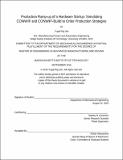| dc.contributor.advisor | Stanley B. Gershwin. | en_US |
| dc.contributor.author | Jain, Yugal Raj | en_US |
| dc.contributor.other | Massachusetts Institute of Technology. Department of Mechanical Engineering. | en_US |
| dc.date.accessioned | 2017-02-22T15:59:33Z | |
| dc.date.available | 2017-02-22T15:59:33Z | |
| dc.date.copyright | 2016 | en_US |
| dc.date.issued | 2016 | en_US |
| dc.identifier.uri | http://hdl.handle.net/1721.1/107026 | |
| dc.description | Thesis: M. Eng. in Advanced Manufacturing and Design, Massachusetts Institute of Technology, Department of Mechanical Engineering, 2016. | en_US |
| dc.description | This electronic version was submitted by the student author. The certified thesis is available in the Institute Archives and Special Collections. | en_US |
| dc.description | Cataloged from student-submitted PDF version of thesis. | en_US |
| dc.description | Includes bibliographical references (pages 106-108). | en_US |
| dc.description.abstract | When ramping up production volumes, hardware startups are required to identify and tackle obstacles in multiple areas of business including finance, sales, engineering, manufacturing, and servicing. NVBOTS, a Boston based 3D printer manufacturing startup, is going through a similar phase of production ramp-up of its printers. This thesis documents the process that the MIT M.Eng. team went through to identify such obstacles at NVBOTS. This process provides insights into what other startups in similar positions may explore. The topic of manufacturing systems was identified as a potential area of improvement as NVBOTS ramps up its production. Discrete event manufacturing simulation models are developed to evaluate two base production strategies -- CONWIP and CONWIP-BtO hybrid. This thesis details the modeling mechanisms used to develop the simulation models. Performance trade-offs that exist for these two production strategies with respect to lead time and production floor inventory levels are analyzed. Effects of various policy levers such as CONWIP and BtO batch sizes are studied, and recommendations for these levers are made. The CONWIP policy is recommended for when lead time requirements for NVBOTS become strict. The CONWIP-Build to Order policy is not recommended given the low lead time benefit it offers compared to a pure Build to Order policy. Following feedback from NVBOTS on these two policies, an advanced Late Stage Differentiation CONWIP-BtO model is developed. This is done to evaluate the potential of late stage differentiation for when NVBOTS expands its product lines. Performance of this policy with respect to lead time and inventory levels is studied for different values of CONWIP and BtO batch sizes, number of workers and worker utilization. Potential plans of action for NVBOTS to tackle higher demands in the future are analyzed. The work described in this thesis covers roughly half of the project on manufacturing systems at NVBOTS. The other half is covered in Alexander Willem Anton van Grootel's thesis [1]. Van Grootel's thesis focuses on capacity estimation of NVBOTS' current facility and variants of the BtO policy. In contrast, this thesis analyzes CONWIP and CONWIP-BtO policies. | en_US |
| dc.description.statementofresponsibility | by Yugal Raj Jain. | en_US |
| dc.format.extent | 119 pages | en_US |
| dc.language.iso | eng | en_US |
| dc.publisher | Massachusetts Institute of Technology | en_US |
| dc.rights | MIT theses are protected by copyright. They may be viewed, downloaded, or printed from this source but further reproduction or distribution in any format is prohibited without written permission. | en_US |
| dc.rights.uri | http://dspace.mit.edu/handle/1721.1/7582 | en_US |
| dc.subject | Mechanical Engineering. | en_US |
| dc.title | Production ramp-up of a hardware startup : simulating CONWIP and CONWIP-build to order production strategies | en_US |
| dc.title.alternative | Simulating CONWIP and CONWIP- BtO production strategies | en_US |
| dc.type | Thesis | en_US |
| dc.description.degree | M. Eng. in Advanced Manufacturing and Design | en_US |
| dc.contributor.department | Massachusetts Institute of Technology. Department of Mechanical Engineering | |
| dc.identifier.oclc | 971164359 | en_US |
